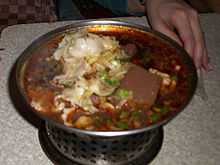- Mala sauce
-
Mala sauce A mala hotpot using mala sauce Chinese 麻辣 Transcriptions Mandarin - Hanyu Pinyin maa4 laat6 Alternative Chinese name Traditional Chinese 麻辣醬 Simplified Chinese 麻辣酱 Transcriptions Mandarin - Hanyu Pinyin málàjiàng Mala sauce refers to a popular Chinese oily spicy and numbing sauce which consists of Sichuanese peppercorn, chili pepper and various spices simmered with oil.
Regarded as a regional dish for Chongqing and Sichuan cuisine, it has become one of the most popular sauces in Chinese cuisine and spawned many regional variants.
Contents
Etymology
The term málà is a combination of two Chinese characters: "numbing" (麻) and "spicy (hot)" (辣), referring to the feeling in the mouth after eating the sauce.
The numbness is caused by Sichuanese peppercorn, which contains 3% hydroxy-alpha-sanshool. The recipe often uses dried bell chili pepper, which is less spicy than the bird's eye chili widely used in Southeast Asian cuisines.
History
The precise origins of the dish are unclear, but many sources attribute its development to night markets in Chongqing that targeted pier workers in the 19th to 20th century[1]. The strong flavour and thick layer of oil helps preserve foods and removes the unpopular smells of the cheap foods, such as solidified blood, beef stomach and kidney, which were usually served to pier workers.
Despite the strong flavour by itself, various dipping sauces are often served to make the texture of cooked meat smooth and oily, and the tastes more complicated. Common sauces include sesame oil with garlic, oyster oil, or doufu ru.
The sauce is used in a variety of ways, from stir-fry, stews, and soup, to being used in hot pot or as a dipping sauce. In the Sichuan and Yunnan provinces mala powder (麻辣粉; pinyin: málàfĕn) is used on snacks and street foods, such as stinky tofu, fried potatoes, and barbecued meat and vegetables.
Ingredients
The sauce is made primarily of dried chili peppers, chili powder, douban paste, Sichuan peppercorns, clove, garlic, star anise, black cardamom, fennel, ginger, cinnamon, salt and sugar. These ingredients are simmered with beef tallow and vegetable oil and for many hours, and packed into a jar. Other herbs and spices, such as sand ginger, Angelica dahurica and poppy seeds, can be added to create a unique flavour.
Traditionally, a restaurant hired a chef specializing in making this sauce; the recipes were kept secret to the chef himself. Today, prepared mala sauce can easily be found in supermarkets, and chain restaurants often produce their own sauce on a large scale, while many others still blend their own one. Like curry, there is a constant debate about the 'best' recipe and numerous variations are available on the market.
The flavour is spicy, numbing (caused by Sichuanese peppercorn) and salty, mixed with a strong herbal taste which is often described as savory, spicy, complicated and addictive.
Dishes
- Mala hot pot (麻辣火鍋)
- Mala duck neck (麻辣鴨脖子)
- Mala bunch (麻辣燙): vegetables and meat skewer served in a mala soup
- Mouth-watering ("drooling") chicken (口水雞): Cold chicken served in mala sauce
- Couples' lung (夫妻肺片): beef tendon, tongue, tripe, and sometimes also lung, served with oily mala sauce
Popular culture
The adjective málà is also used in Mandarin slang to mean 'sexy', 'wild' much like 'hot' in English. The Mandarin title of the animated series Kim Possible is Málà Nǚhái (麻辣女孩; literally 'numbing-hot girl').
See also
External links
Reference
Hot sauces Adobo • Aji (food) • Ajvar • Bajan pepper sauce • Biber salçası • Blair's Sauces and Snacks • Búfalo • Cholula Hot Sauce • Crystal Hot Sauce • D'Elidas • Dave's Gourmet • Doubanjiang • El Yucateco Chile Habanero • Filfel chuma • Frank's RedHot • Gochujang • Harissa • Huy Fong Foods • Jaew bong • Llajwa • Louisiana Gold Hot Sauce • Louisiana Hot Sauce • Mojito isleño • Mojo (sauce) • Pebre • Pickapeppa sauce • Ro*tel • Sambal • Scorpion Bay Hot Sauce • Shito • Skhug • Sriracha sauce • Tabasco sauce • Tapatío hot sauce • Texas Pete • Trappey's Hot Sauce • Valentina (sauce)Sichuan cuisine Ants climbing a tree · Dan dan noodles · Doubanjiang · Fuqi feipian · Guaiwei · Guoba · Hot and sour soup · Hot pot · Kung Pao chicken · Mala sauce · Mapo doufu · Pao cai · Shuizhu · Sichuan pepper · Suanla chaoshou · Tuotuorou · Twice cooked pork · Wonton · Wuliangye Yibin · Yuxiang · Zha cai · Zhangcha duckCategories:- Chinese condiments
- Hot sauces
- Sichuan cuisine
Wikimedia Foundation. 2010.

